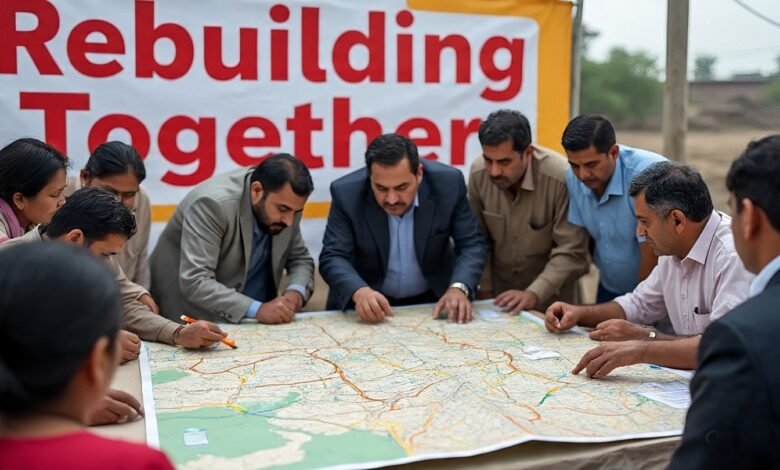
How Businesses Can Rebuild After Sutlej River Floods in South Punjab
Learn proven strategies for business recovery after Sutlej River floods in South Punjab. Expert guidance on rebuilding, financial aid, and resilience planning.
The devastating Sutlej River floods of 2025 have left an unprecedented mark on South Punjab, affecting over 4.2 million people and destroying thousands of businesses across the region. As floodwaters recede, business owners face the daunting task of rebuilding their enterprises from the ground up. The floods, described as the worst in Punjab’s history, have created a complex web of challenges that require strategic planning and community-driven solutions.
Business recovery after floods isn’t just about repairing physical damage – it’s about creating a foundation for long-term resilience. Research from previous Pakistani flood disasters shows that while 90% of businesses can reopen within six months, most initially operate at a loss. The key lies in understanding which strategies accelerate recovery and which pitfalls to avoid.
This comprehensive guide examines proven flood recovery strategies specifically tailored for South Punjab’s unique challenges. From accessing government support programs to rebuilding supply chains, we’ll explore how businesses can not only recover but emerge stronger. Whether you’re a small retailer in Kasur district or an agricultural enterprise near the Pakistan-India border, these strategies will help you navigate the complex path to recovery while building resilience against future climate disasters.
Understanding the Scale of Damage from Sutlej River Floods
The 2025 Sutlej River floods have created an economic crisis of massive proportions across South Punjab. According to Punjab’s Disaster Management Authority, over 4,400 villages have been affected, with floodwaters reaching levels not seen in 35 years. The economic toll extends far beyond immediate infrastructure damage, creating ripple effects that will impact businesses for months to come.
Agricultural businesses have borne the brunt of the destruction, with flash floods destroying 60% of rice crops, 30% of sugarcane, and 35% of cotton fields across the region. For businesses dependent on agricultural supply chains, this represents a fundamental disruption that requires strategic pivoting and alternative sourcing strategies.
Infrastructure damage has compounded these challenges, with over 661 kilometers of roads destroyed and hundreds of bridges washed away. This infrastructure destruction has created significant logistics bottlenecks, forcing businesses to completely rethink their distribution strategies and supply chain management.
Small businesses face particularly acute challenges, as many lack the financial reserves to weather extended periods of reduced revenue. Research from Pakistan’s 2010 floods indicates that businesses with limited cash flow, high dependency on local transportation, and significant inventory losses face the longest recovery periods.
Immediate Steps for Business Assessment and Damage Control
The first phase of business recovery after floods requires systematic damage assessment and immediate stabilization measures. Business owners should begin by conducting a comprehensive evaluation of physical assets, inventory losses, and operational capabilities.
Document all flood damage meticulously, as this documentation will be crucial for insurance claims and government assistance applications. Take photographs and videos of damaged equipment, inventory, and infrastructure before beginning any cleanup efforts. This visual evidence serves as critical proof for financial recovery programs.
Prioritize safety assessments before allowing employees back into flood-affected facilities. Electrical systems, structural integrity, and water contamination all pose serious risks that must be addressed by qualified professionals. The cost of proper safety assessments is minimal compared to potential liability issues or employee injuries.
Cash flow management becomes critical during this phase. Contact banks immediately to discuss loan modifications, payment deferrals, or emergency credit lines. Many financial institutions in Pakistan have established special programs for flood-affected businesses, but these typically require early application.
Inventory management requires immediate attention to prevent further losses. Salvageable goods should be moved to dry storage quickly, while damaged inventory should be properly documented and disposed of according to local regulations. Some businesses have successfully recovered partial value from damaged goods through specialized auction houses or bulk sales to recycling operations.
Accessing Government Support and Financial Assistance Programs
The Pakistani government has established multiple financial assistance programs specifically designed to support flood-affected businesses in South Punjab. Understanding and accessing these programs can significantly accelerate your recovery timeline.
The Punjab government has announced electricity and tax relief packages for flood-affected families and businesses. These programs include temporary exemptions from utility payments and reduced tax burdens during the recovery period. Application processes typically require proof of flood damage and business registration documents.
Small business recovery programs often provide direct cash grants, low-interest loans, and equipment replacement assistance. The National Disaster Risk Management Fund (NDRMF) coordinates many of these efforts, but applications must be submitted through district-level disaster management authorities.
Banks and financial institutions have activated special lending programs with relaxed collateral requirements and extended repayment terms. These disaster recovery financing options often feature significantly lower interest rates than standard commercial loans, making them attractive for businesses with solid pre-flood operational histories.
International development organizations, including the World Bank and Asian Development Bank, have committed billions in reconstruction funding. While much of this focuses on infrastructure, portions are designated for private sector recovery through local implementing partners.
Working with local chambers of commerce and business associations can streamline the application process for government programs. These organizations often have dedicated staff to help members navigate bureaucratic requirements and can provide valuable networking opportunities with other recovering businesses.
Rebuilding Supply Chain Networks and Vendor Relationships
Supply chain recovery represents one of the most complex challenges facing flood-affected businesses in South Punjab. The interconnected nature of regional commerce means that even businesses with minimal direct damage may struggle with disrupted supplier networks.
Assess your entire supply chain systematically, identifying which vendors have been affected and developing contingency plans for critical inputs. Businesses that established diverse supplier networks before the floods typically recover faster than those dependent on single-source suppliers.
Transportation infrastructure damage requires creative logistics solutions. Some businesses have successfully partnered with competitors to share transportation costs and coordinate deliveries. This collaborative approach can significantly reduce per-unit shipping costs while building valuable business relationships.
Alternative sourcing strategies may require temporary shifts to suppliers outside the flood-affected region. While this often increases costs initially, it can maintain business operations during the critical recovery period. Document these additional costs carefully, as many assistance programs reimburse businesses for flood-related expense increases.
Local vendor relationship management becomes crucial as everyone works to rebuild simultaneously. Maintaining open communication with suppliers about timeline expectations and payment flexibility can preserve valuable partnerships during difficult periods.
Consider implementing technology solutions to improve supply chain visibility and resilience. Digital platforms that track inventory levels, automate reordering, and provide real-time supplier communication can help prevent future disruptions and streamline current recovery efforts.
Restoring Operations: Infrastructure and Equipment Priorities
Infrastructure rebuilding requires strategic prioritization to maximize business recovery speed while managing limited financial resources. Focus on restoring the minimum viable infrastructure needed to resume core operations before investing in improvements or expansions.
Electrical systems demand immediate professional attention due to safety concerns and insurance requirements. Water-damaged electrical equipment must be completely replaced, as repair attempts often fail and create ongoing safety hazards. Factor electrical restoration into your critical path planning, as delays here will impact all other recovery activities.
Equipment replacement decisions should balance immediate operational needs against long-term strategic goals. Some businesses use flood recovery as an opportunity to upgrade to more efficient or resilient equipment, especially when insurance or assistance programs provide funding beyond simple replacement costs.
Building modifications can incorporate flood resilience features that reduce future vulnerability. Elevated storage areas, improved drainage systems, and flood-resistant building materials may qualify for additional grants while providing long-term cost savings.
Technology infrastructure often suffers significant damage but can be rebuilt with improved capabilities. Cloud-based systems, remote backup solutions, and mobile-friendly platforms can provide business continuity benefits that extend far beyond flood recovery.
Workspace design should consider lessons learned from the flooding experience. Flexible layouts that allow rapid equipment elevation, waterproof storage solutions, and evacuation-friendly floor plans can minimize future flood impacts.
Financial Recovery Strategies and Cash Flow Management
Financial recovery requires both immediate cash flow stabilization and long-term financial planning. The period immediately following floods typically involves significant cash outflows with limited revenue generation, making careful financial management essential.
Emergency cash flow management should prioritize essential expenses: employee salaries, critical supplier payments, and minimum debt service. Create detailed cash flow projections for at least six months, updating them weekly as circumstances change.
Insurance claim management can provide substantial recovery funding but requires systematic documentation and persistent follow-up. Work with experienced claims adjusters who understand flood damage, and maintain detailed records of all conversations and submissions.
Revenue diversification strategies can help businesses survive extended recovery periods. Some businesses successfully pivoted to providing flood cleanup services, emergency supplies, or reconstruction support during their own recovery process.
Working capital management becomes critical when normal payment cycles are disrupted. Negotiate extended payment terms with customers when possible, while maintaining good relationships through transparent communication about your recovery timeline.
Consider factoring or invoice financing to accelerate cash collection on outstanding receivables. These financing tools can provide immediate liquidity while waiting for normal payment cycles to resume.
Tax planning should account for potential disaster-related deductions and credits. Business losses from floods may qualify for special tax treatment, and accelerated depreciation schedules might be available for replacement equipment.
Building Community Networks and Collaborative Recovery
Community support networks have proven essential for successful business recovery throughout Pakistan’s history of natural disasters. Businesses that actively engage with community recovery efforts typically achieve faster and more sustainable rebuilding outcomes.
Local business associations provide valuable coordination platforms for sharing resources, information, and recovery strategies. These networks often negotiate group discounts on restoration services and facilitate knowledge sharing between businesses facing similar challenges.
Collaborative recovery initiatives can reduce costs and accelerate timeline for multiple businesses simultaneously. Shared infrastructure projects, joint equipment purchases, and coordinated supplier negotiations provide benefits that individual businesses cannot achieve alone.
Worker support programs help maintain valuable employee relationships during recovery periods. Businesses that provide continued support to displaced workers often benefit from faster workforce restoration and improved employee loyalty.
Customer communication strategies should emphasize community solidarity and mutual support. Businesses that position themselves as community recovery partners often build stronger customer relationships than those focused solely on individual recovery.
Volunteer coordination can provide valuable labor resources while building community goodwill. Many successful recovery stories involve businesses that effectively organized volunteer efforts for both their own recovery and broader community needs.
Public-private partnerships offer opportunities to align business recovery with broader community development goals. These partnerships can provide access to additional funding sources and create synergies that benefit multiple stakeholders.
Long-term Resilience Planning and Risk Management
Climate resilience planning must become integral to business strategy given Pakistan’s increasing vulnerability to extreme weather events. The 2025 floods represent part of a broader pattern of climate-related disasters that require systematic risk management approaches.
Disaster preparedness strategies should address multiple risk scenarios, including floods, droughts, and other climate-related disruptions. Businesses that develop comprehensive emergency response plans recover faster when disasters occur.
Insurance portfolio optimization should reflect lessons learned from the current flooding experience. Many businesses discover significant gaps in their coverage during disaster recovery, making post-flood insurance review essential.
Business continuity planning should include remote work capabilities, distributed inventory storage, and alternative location strategies. Technology solutions that enable business operations from multiple locations provide valuable flexibility during crisis periods.
Financial resilience requires building adequate emergency reserves and establishing multiple financing relationships before disasters occur. Businesses with strong pre-disaster financial positions have significantly more recovery options than those operating with minimal reserves.
Stakeholder relationship management extends beyond immediate business needs to include government agencies, community organizations, and international development partners. These relationships can provide crucial support during future crisis periods.
Training and capacity building ensure that your workforce can implement emergency procedures effectively. Regular drills and updated training materials help maintain organizational preparedness without disrupting normal operations.
Technology Solutions for Modern Business Recovery
Digital transformation can accelerate business recovery while building long-term operational advantages. Many businesses use post-disaster rebuilding as an opportunity to implement technology solutions that improve efficiency and resilience.
Cloud-based systems provide business continuity benefits that extend far beyond disaster recovery. Customer relationship management, accounting, and inventory management systems hosted in the cloud remain accessible even when physical locations are damaged.
Mobile commerce platforms enable businesses to continue sales operations even when physical storefronts are unavailable. Social media marketing and e-commerce capabilities can maintain customer relationships and generate revenue during facility reconstruction.
Digital payment systems reduce cash handling requirements and provide transaction records that simplify financial management during recovery periods. These systems also enable businesses to serve customers from temporary locations with minimal infrastructure requirements.
Communication technology becomes essential for coordinating recovery efforts across multiple stakeholders. Project management platforms, messaging systems, and video conferencing tools help maintain operational efficiency during complex rebuilding processes.
Data backup and recovery systems prevent total information loss during future disasters. Businesses that implement comprehensive backup strategies can resume operations much faster after infrastructure damage.
Analytics and monitoring tools provide insights into recovery progress and help identify optimization opportunities. Businesses that track recovery metrics systematically often identify bottlenecks and inefficiencies that can be addressed proactively.
Conclusion
The Sutlej River floods in South Punjab have created unprecedented challenges for businesses across the region, but history shows that strategic recovery planning can lead to stronger, more resilient enterprises. Successful business recovery after floods requires a systematic approach that addresses immediate stabilization needs while building long-term resilience against future climate disasters. By accessing available government support programs, rebuilding supply chain networks thoughtfully, and implementing modern technology solutions, businesses can not only recover but emerge more competitive than before. The key lies in viewing recovery not just as restoration, but as an opportunity to build climate resilience and operational efficiency that will serve businesses well in Pakistan’s changing environmental landscape. With proper planning, community collaboration, and strategic implementation of these recovery strategies, South Punjab’s business community can rebuild stronger than ever.







